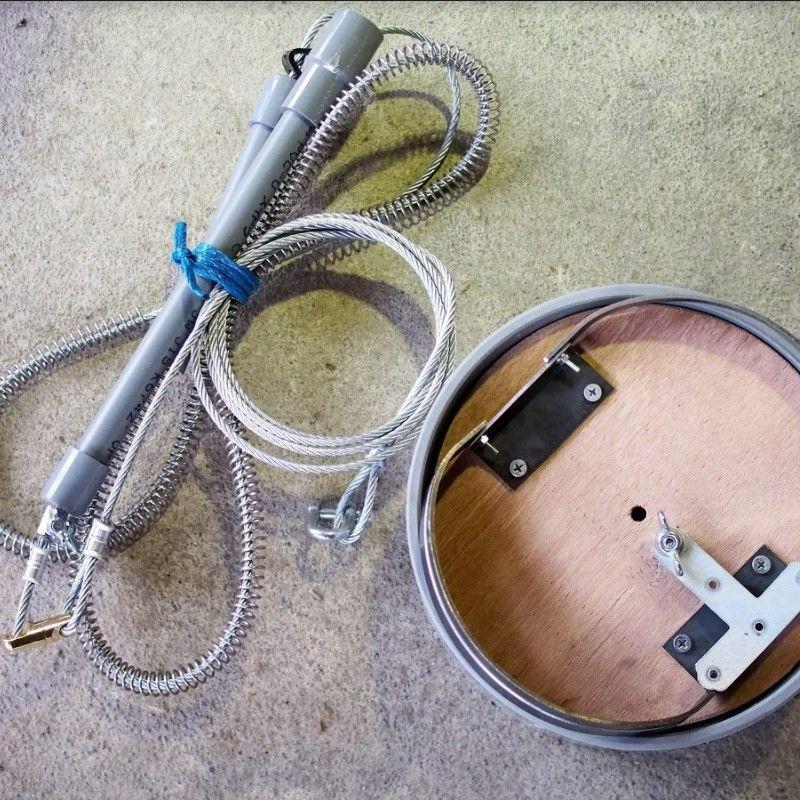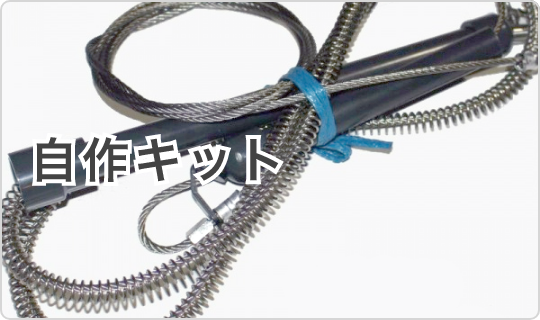Kukuri Trap Features and Installation Method

Kukuri Trap is a tool that has been used since ancient times to capture wild boars, deer, and other animals. It is captured by "tying" the animal's legs with wire.
Our store has a track record of selling thousands of tying traps every year. We are trying to create products that will be useful to everyone who is facing countermeasures.


I want to find a trap that suits me
If you are looking for a set that can be set up immediately, if you want to purchase only the treads, or if you want to purchase parts and make your own, we have products that suit your situation. Please choose the product that suits your situation.
Inohoi's Recommended Kukuri Trap Set
Inohoi recommends the following 3 types of set products. The footboard, footboard pedestal, and mechanism are all included as a set, so no assembly work or tools are required. Ready to work as soon as it arrives
 Wild boar and deer tying trap Strong Finished product A sturdy type tying trap that is not easily broken and is the most cost-effective type.
Wild boar and deer tying trap Strong Finished product A sturdy type tying trap that is not easily broken and is the most cost-effective type.The part where the snare (the wire rope loop that binds the legs of the prey) is attached is made of metal, and the tread is made of thick PVC resin, making it a very popular type that is less likely to corrode or deteriorate like a wooden board.
Click here for details>>
How to set a trap
Here, we will explain how to set up a tying trap, taking the "flip-up type" type that we handle as an example. * Each product in our store comes with an instruction manual that describes how to install it, so please refer to that when purchasing.

① Find traces of the target
Tie traps need to be pinpointed in anticipation of where the beast will place its paws. The most important thing when setting a kukuri trap is the selection of the location, but in order to set it in a good location, carefully observe the tracks of the beasts and set the trap in the beast trail that they will use frequently.
It is necessary to check for areas where the surrounding plants are covered with mud that a wild boar must have made, or where there are solid footprints.

②Fill the pedestal in the installation location
Dig a hole to set up the tying trap in the place you decided to "here!" in ①, and fill the pedestal. If the soil in the digging area is prone to crumbling, it may collapse and malfunction, so try to set it in a place where it will not crumble as much as possible.
If it is unavoidable, harden the surrounding soil when setting it up so that the surroundings of the trap will not collapse even if the beast steps on it.

③ Choose a netsuke location
Look for tree trunks and values to support the tying trap. At this time, it is important to choose a solid rooting place within the reach of the wire. If you choose a place that is easy to break, the captured beast will escape, and if it breaks when confronted with the beast after capture, there is a risk of counterattack. If you install it on a slope, it's a good idea to root it below where you set the trap.

④ Attach the snare to the tread and compress the compression spring
A snare (a loop of wire rope that binds the prey's legs) is set on the arm of the footboard, and the spring that powers the tying trap is compressed.
The springs used in tying traps are strong, so put your weight firmly on them and compress them by pushing them into the PVC pipe. After compressing the spring firmly, fix the stopper to keep the spring compressed.

⑤ Add camouflage
Place the footboard set in step 4 on the pedestal and cover it with soil or dead leaves so that it is not visible to the prey (cover it as thinly as possible). If the edge of the footboard is stepped on, the balance of the load will be unbalanced, making it easier for the product to malfunction or escape. It is a good idea to make the surrounding area difficult to step on with obstacles (tree branches, stones, etc.) and guide the stepping on the central part of the footboard.

(6) Patrol is important after installation
Once you've set up your traps, don't leave them alone, but check them out daily. Even if you can't catch it, check the traces of the prey and try to anticipate its behavior. If there is empty repelling (malfunction), we will investigate the cause and improve the installation method.
If you find that you have caught it, do not approach it carelessly and check the condition of the trap from a distance.
About our tie-up trap

high catch rate
One of the most common comments we receive from customers using our tying traps is that they were able to catch them immediately after setting them. We have many patrons from beginners to veterans.

easy to set
Based on many usage results, we have developed products with simple mechanisms and ease of handling in mind. We are also introducing a Youtube video , so please take a look.

Affordable price
We are devising the manufacturing process and striving to improve it every day so that it is an affordable product for those who are suffering from damage. Bulk purchase discounts are available depending on quantity.
Introducing Takukuri Trap Impressions from Customers
| Product used: boar hoi hoi |
“I bought this trap because there was damage from wild boars. The condition of the product was good, and although it was my first time setting a trap, it was an easy-to-handle trap. 』 |
|---|---|
| Product used: boar hoi hoi |
“Packing was also polite and quick delivery. We were able to exterminate on the next day if we installed immediately on day when we arrived. 』 |
| Product used: Tie Trap Strong |
“Deer eat shiitake mushrooms, so I planted several in a nearby orchard and was able to catch three at once. 』 |
| Product used: Tie Trap Strong |
"I'm still a beginner, but I was able to set it up well. It's well made!” |
| Product used: Trap "TSJ" for foot and nose tie |
“Since it is easy to install, you can set it up in no time. Even if it is a nose tie, it can be held in a short time and can be captured more safely. 』 |
If you want to replace or make your own, this is also recommended!
Introduction of survey results on the use of tying traps
We conduct surveys to improve the quality of our services and products. Some of the results are shown below for your reference.
- Please let us know which animals are affected.
-

More than 90% of the damage was caused by wild boars, accounting for the majority. According to the Ministry of Agriculture, Forestry and Fisheries, the amount of damage to agriculture, forestry and fisheries caused by wild boars was about 4.7 billion yen in 2018, and it is a serious situation that is a matter of life and death especially for farmers. - Please tell us about your hunting history.
-

Beginners and veterans had almost the same ratio. We strive to make our products easy to handle for novice hunters who want to learn hunting techniques, and to satisfy even experienced hunters. - Please tell us the wire diameter that you think is suitable for tying traps.
-

4 mm diameter accounted for the majority. After all, it seems that there are many people who emphasize ease of operation and ease of handling. On the other hand, there are also people who value strength in consideration of the case where a large object is caught. - (Extra) Please tell us how you first found out about this site.
-

I received the result that the Internet is more than 90%. We are constantly improving the usability and visibility of the site so that you can shop conveniently on the Internet. Of course, we also accept inquiries and orders by phone.
Kukuri Trap Useful Knowledge
[Weekly] Wildlife damage countermeasures are regularly updated with know-how that is useful for setting up tying traps. Please refer to it to improve the capture rate.
Popular articles related to tying traps
Various selectable tying trap lineup
The finished product is ready for use as soon as it arrives. If you prepare the spring part by yourself, we recommend purchasing only the footboard. Click here for a list of all Kukuri Trap products .
Necessary parts for tying traps
There are rules that must be observed when catching wild boars and deer in traps. As for the requirements of the trap itself, the use of tying traps that fall under the following is prohibited in principle.
1: Something that lifts prey
2: Wire diameter less than 4mm
3: Those without "return"
4: Those without "tightening prevention metal fittings"
5: The diameter (in the case of an oval, the smaller one) must be over 12cm
6: Hanging 31 or more traps by one person
Regarding *5, diameter restrictions have been relaxed in many regions. Please check with the section in charge of the local government where the capture is being carried out for the presence or absence of regulations.
 It is a fitting that relieves twisting of wires and prevents wire damage (kinks). Also called a Sarkhan swivel.
It is a fitting that relieves twisting of wires and prevents wire damage (kinks). Also called a Sarkhan swivel.Learn more>>

 箱罠
箱罠
 くくり罠
くくり罠
 パーツ類
パーツ類
 電気柵
電気柵
 自作キット
自作キット
 防獣グッズ
防獣グッズ
 監視カメラ
監視カメラ
 Trap Trap Wild Boar Hoi Hoi Finished product
Trap Trap Wild Boar Hoi Hoi Finished product  TSJ
TSJ 










 box trap
box trap
 tying trap
tying trap
 enclosure trap
enclosure trap
 Prevention and avoidance goods
Prevention and avoidance goods
 electric fence
electric fence
 trap surveillance camera
trap surveillance camera
 transportation goods
transportation goods
 Trap detection sensor
Trap detection sensor
 hunting supplies
hunting supplies
 hunting books
hunting books
 Anti-bird goods
Anti-bird goods
 Agricultural materials/machinery
Agricultural materials/machinery
 boar
boar
 deer
deer
 Kyon
Kyon
 monkey
monkey
 raccoon
raccoon
 Badger
Badger
 palm civet
palm civet
 raccoon dog
raccoon dog
 nutria
nutria
 mouse or rat
mouse or rat
 Mole
Mole
 bear
bear
 pigeon
pigeon
 Crow
Crow







